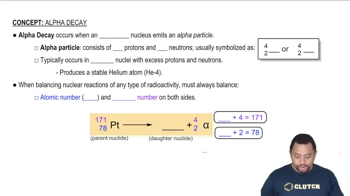Here are the essential concepts you must grasp in order to answer the question correctly.
Nuclear Reactions
Nuclear reactions involve changes in an atom's nucleus and can result in the transformation of one element into another. These reactions include processes such as alpha decay, beta decay, and nuclear fission. Understanding the type of nuclear reaction is crucial for writing balanced nuclear equations, as it dictates the particles involved and the resulting isotopes.
Recommended video:
Alpha Emission
Alpha emission is a type of radioactive decay in which an atomic nucleus emits an alpha particle, consisting of two protons and two neutrons (essentially a helium nucleus). This process decreases the atomic number of the original nucleus by two and the mass number by four, resulting in the formation of a new element. Recognizing the characteristics of alpha particles is essential for accurately balancing nuclear equations.
Recommended video:
Balancing Nuclear Equations
Balancing nuclear equations requires ensuring that both the mass number and atomic number are conserved during the reaction. This means that the sum of the mass numbers and the sum of the atomic numbers on the reactant side must equal those on the product side. Mastery of this principle is vital for correctly representing nuclear processes, such as the alpha emission of isotopes.
Recommended video:
Balancing Chemical Equations

 Verified step by step guidance
Verified step by step guidance


